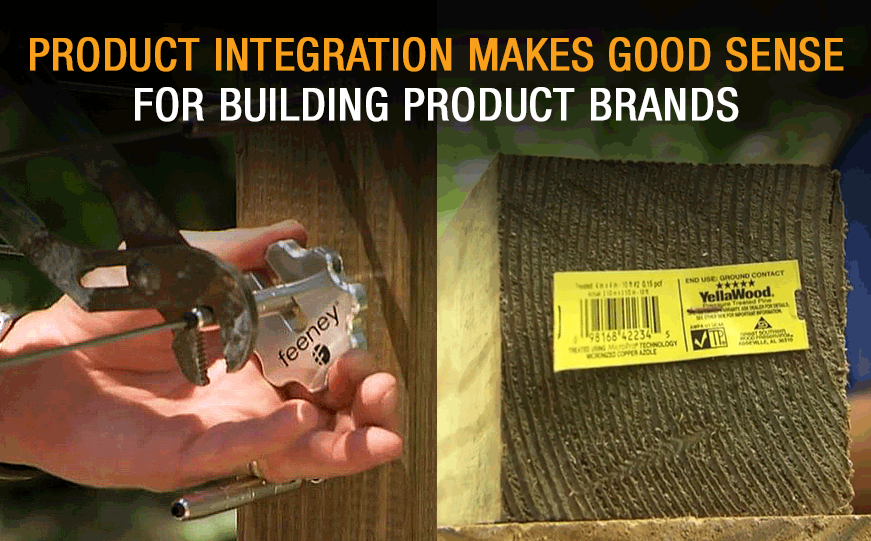Increasingly, companies are looking at more creative ways to help consumers learn about their brands. While traditional marketing tactics such as print, broadcast and digital advertising continue to remain relevant, more brands are turning to approaches such as blogger/ influencer partnerships and product integration to elevate brand awareness.
Product integration, in particular, is growing in popularity as consumers are increasingly looking to view products in “real world” scenarios. They want to know exactly what a product does and how it works. “Show me, don’t tell me,” as the saying goes. The goal of product integration in its most basic form is to secure exposure for a brand by incorporating it into the theme of a story produced by a broadcast or print media outlet.
For building product brands, that often means placing a product in a home improvement television show or a show home. Essentially, the product is installed during a new build or renovation project and the hosts of the show mention the product and, in some cases, speak about it in detail. In exchange for being promoted in the show (or show home) and in related promotional activities, the building product brand donates product, provides product at a reduced cost or pays a fee.
Fortunately, with the advent of networks such as HGTV, Bravo and the DIY Network, product integration opportunities abound.
At K&A, we’ve managed numerous successful product integrations for our clients. Most recently, our client Feeney, a provider of architectural solutions for residential and commercial projects, partnered with Today’s Homeowner with Danny Lipford.
In fact, Feeney’s cable railing was seamlessly integrated into the show’s narrative. The hosts, Danny Lipford and his daughter Chelsea — who happen to be fans of CableRail — discussed the ease of installation, durability and how the railings open up the view from the deck.

As part of the agreement, Lipford and his team showed Feeney’s packaging and close-ups of the product along with the finished deck and, of course, commentary from the happy homeowners. But, unlike an advertisement — which is written ahead of time with carefully chosen words — the comments from both Lipford’s team and the homeowners were organic and spontaneous… crafted from our supplied messaging.
Audiences appreciate the difference. After all, we’re all consumers… and a message delivered from authentic experience will always hold more credibility than one delivered from a script.
In addition to exposure on the episode, our client received a custom video clip to promote on their website, in an e-newsletter and on their social media platforms… along with photography and a blog post on the Today’s Homeowner website.
Another of our clients, Amba Products — a manufacturer of heated towel racks — has participated in several show homes during the past year, including the Fox Hill Showcase of Homes in Denver and the Atlanta Homes & Lifestyles Home for the Holidays showhouse. Amba not only had its products displayed (along with signage) and was included in all show home promotions, but also received high res photography and multiple social media mentions.
Promotional Opportunities
Prior to agreeing to a product integration, it’s important for brands to negotiate the specific promotional opportunities they will receive. This will help to ensure optimal brand exposure and a positive return on investment.
While each product integration or show home will be unique, following are six strategies that building product brands should keep in mind when evaluating a product integration opportunity:
- Reach. What is the estimated number of consumers who will see the episode or visit the showhouse? (i.e., reach/viewers/impressions)
- Recognition. Will the product’s logo be clearly obvious during the episode or event? (packaging, signage or inclusion in show credits.)
- Review. Will the product’s performance be reviewed? If so, will the brand get the opportunity to see the outcome before the episode is aired?
- Assets. What promotional deliverables will the brand receive in exchange for participation in the product integration? For example: high res photography, video clips of installation or review, social media promotion, inclusion of product and/or logo on show or showhouse website, blog post, write-up in e-newsletter, etc.
- Access. Will the episode be re-broadcast and/or archived on the show website for future access?
- Publicity. Can permission be arranged for the brand to publicize the integration on its own website, social media sites and/or in its e-newsletter?
Remember that product integrations should be a mutually beneficial partnership. It’s important not to be afraid to negotiate with the producers of the show or organizers of the showhouse. The goal is to get your brand in front of as large an audience as possible. And, while relationships are ultimately built on trust, it’s vital to get any promised promotion and photo/video rights in writing… to make sure both parties are aligned when it comes to framing expectations.
Interested in learning how to elevate your brand’s exposure through a product integration? Send an email to Steve Kleber at sk@kleberandassociates.com.




